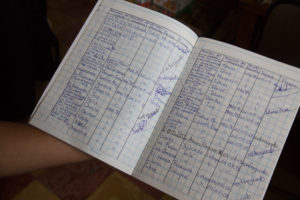
When Child Aid Country Director John van Keppel and Library Coordinator Carlos Pos visited the library at the public school in Agua Escondida earlier this month, they were thrilled to see the librarian, Clara Luz Mox Umul, and a group of students huddled around a small plastic box. They were using a new checkout system, introduced at a Child Aid librarian training just a few weeks earlier and designed to help promote and facilitate book lending at our partner libraries.
“It’s great to see Clara using the box already and that kids are checking out books,” commented van Keppel as he flipped through the student cards, filled with the names of books they had borrowed. “It’s a simple tool, but one that will hopefully help us get more books in the hands of kids.”
Child Aid’s work with libraries is based on the belief that the more kids have access to books the more opportunities they will have to read and learn. We focus on creating libraries that are resources for literacy in their schools and communities by providing hundreds of high-quality children’s books, including story books, textbooks and reference books.

But even with these additional resources, there can be other barriers. For example, because books in these communities are an expensive and rare resource, rural libraries can be reluctant to lend them out and do not have a reliable circulation system for lending to students. Books can sit on shelves – sometimes behind lock and key – and be inaccessible to readers.
In Child Aid’s librarian trainings, librarians like Clara learn skills to help them make their libraries more accessible to the community. They learn how to transform their libraries into welcoming environments, run programs and activities that promote literacy, and set up systems to lend books to schools, students and community members.
But earlier this year, van Keppel and the Library Development team noticed that the partner libraries were not checking out books to students as much as they had hoped.
“Every library we work with does lending a bit differently,” says van Keppel, “and many do not do it very well.”

Librarians often use a ledger book, writing down each book and its due date chronologically as it is checked out. The process is laborious and makes it difficult to keep track of when books are due and which books are overdue.
“We realized that if we wanted to promote lending, we needed to introduce a system that was easy to use and would be consistent across all our partner libraries.”
So Pos and the rest of the Child Aid staff set to work designing a simple checkout system that would be cheap to set up and easy for librarians to implement. Now every student has a card with their book titles and due dates recorded on a single page. Overdue cards go into a red folder for tracking and reminders, making it easier for librarians to manage their inventories and prevent losses.
“It seems to be working well so far,” says Pos. “I have visited three or four other libraries that have already implemented the lending system. We’ll continue to follow-up with the librarians and make improvements as we go along.”
Van Keppel hopes that having all the libraries on a single system will allow Child Aid’s staff to provide better support to librarians and make lending a routine part of the libraries’ work. It may also set the stage for future improvements such as tracking usage and reading habits of students or creating a digitized checkout system.
It is one of Child Aid’s many small innovations that are helping overcome barriers to literacy in these rural communities and giving students access to the books they need to learn and grow.